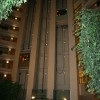Elevators
Lead-Lined Materials
Lead-lined materials are installed in buildings to prevent occupants’ exposure to radiation. There are three main types of radiation (alpha, beta, and gamma/X-ray) that humans can be exposed to, either naturally or through the normal operation of radiation emitting equipment or processes. Gamma and X-ray radiation are very similar. They are a penetrating type of high energy, high frequency electromagnetic radiation produced by X-ray operations in the medical field, and during the decay of radio-active materials in industrial applications. Lead is the material of choice to offer shielding from gamma and X-ray radiation, since it is a dense element with a relatively high atomic number, which is important for the absorption of electromagnetic radiation. Lead is cheap, available, and malleable, with a history of proven effectiveness for electromagnetic radiation protection.
Modular Mezzanines
Modular mezzanines are a convenient and cost-effective method of quickly creating additional floor space within the interior of an existing large structure, such as a warehouse, retail store or industrial building. Popular designs include structural framing, stairs, and steel grate decking. The most common purpose of modular mezzanines is to provide additional storage space. Some specialized modular mezzanines provide enclosed rooms with complete utility services, including lighting and air conditioning, to create offices and finished interior spaces.
Grandstands and Bleachers
Grandstands and Bleachers provide seating for both indoor and outdoor spectator events which typically have several hours duration. Bleachers are terraced rows of bench seats with foot rests. Grandstands are bleachers or individual seating systems on an elevated platform. Many grandstand and bleacher systems can be easily relocated if purchased, or rented for specific events. Permanent installations at fixed interior building locations can be installed with telescopic features, to allow for improved storage and floor cleaning when not in use. Wood, aluminum and plastics are the most common material selections for bleacher and grandstand seating.
Greenhouses
Greenhouses are designed to take advantage of solar radiation to create a proper environment and temperature for plant cultivation. Solar radiation heats all greenhouse contents, and the glazing traps the heat generated within the structure. Even heating of the greenhouse contents mitigates the loss of heat by convection (warm air tends to rise and escape a structure), which is another important functional aspect of a greenhouse. Greenhouse building components consist of a foundation, framing, glazing, ventilation, utilities and thermal storage systems. Temporary and portable greenhouses may not require all these components.
Fabric Structures
Modern manufacturing has allowed for the expanded use of advanced fabric materials for the construction of temporary and permanent building structures. The types of fabrics and fabric support techniques are diverse, as are the potential construction applications for fabric building systems. These include standalone portable shelters of all sizes (including storage sheds and hangars), permanent structures with completely fabric roofs (including stadiums and airport terminals), and fabric additions to traditionally constructed buildings, such as awnings and lean-tos.
Vaults
Vaults or strong rooms provide a secure space, typically within a bank building, for the storage of cash or other items of high monetary value. There are three basic Underwriter’s Laboratory (UL) burglary-resistance ratings available for vaults: Type I, II, and III. These are based on the time it would take to break into a vault using commonly available tools to compromise it, within 30, 60, or 120 minutes, respectively, for types I through III. The ratings are achieved through actual demonstration tests by UL employees. There is also a Type M 15 minute rating.
Sound-Conditioned Rooms
Sound conditioned rooms seek to reduce or nearly eliminate noise propagation through a building space, and are used when quiet settings are required. Sound waves coming from outside which create noise within a room can be mitigated by absorbing them after they enter, or, preferably, by dampening them before they enter a room. The same concept applies in reverse when trying to contain noises within a room. Examples of sound conditioned rooms include music recording studios and building mechanical rooms which contain heating and cooling equipment. Different methods of sound conditioning a room are required depending upon whether the room is part of a new construction project or whether it is being retro-fitted after construction. New construction allows the greatest potential for noise reduction, since the goals are known during initial design. Retro-fitting efforts rely more commonly on sound absorption materials than they do upon dampening techniques that can be consciously designed in during initial construction plans.
Swimming Pools
Swimming pools range in size from small inflatable pools to large Olympic size pools, and the even larger pools now used at water parks. Pools can be classified as either above-ground or in-ground; however, there are variations of these classifications which are designed and constructed to fit the circumstances. Above-ground pools are generally constructed of vinyl and metal or wood; they are easy to build and less costly to construct than in-ground pools, but are less durable. In-ground pools can be constructed of a number of different products, including fiberglass, steel and concrete. Pools constructed inside buildings require appropriately designed equipment to ensure appropriate humidity levels and the required ventilation.
Seismic Instrumentation
This topic includes information related to seismic instrumentation. Seismic instrumentation are used to evaluate, measure and record the effects of earthquake occurrences that effect a building.
Stress Instrumentation
This topic includes information related to stress instrumentation. Stress instrumentation are used to evaluate, measure and record structural stress occurrences that effect a building.
